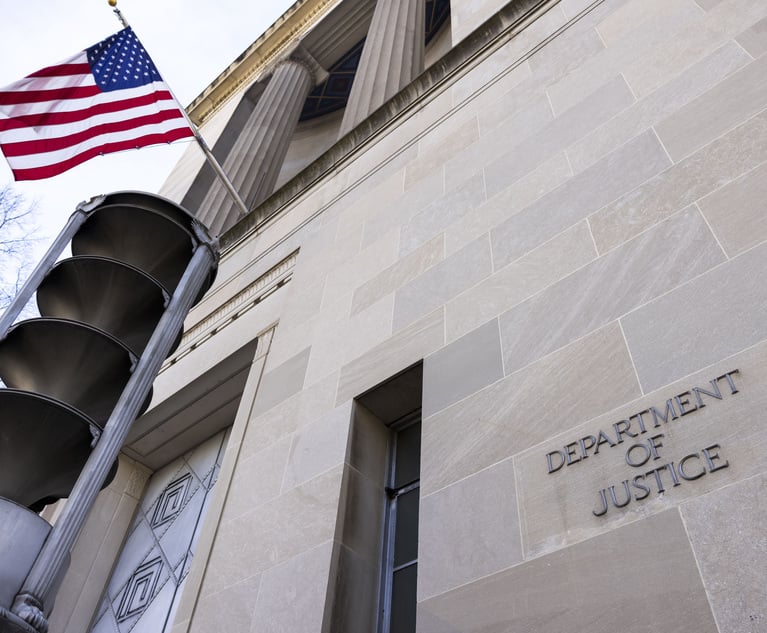 L-R: Lilya Tessler, Scott Parel and Angela Zambrano of Sidley Austin. Courtesy photos
L-R: Lilya Tessler, Scott Parel and Angela Zambrano of Sidley Austin. Courtesy photos Web 3.0: How Will Blockchain Impact Your Practice?
"There have been no shortage of government enforcement actions in this space, yet the law is far from settled," write Sidley Austin's Lilya Tessler, Scott Parel and Angela Zambrano.
September 12, 2024 at 11:00 AM
8 minute read
An understanding of legal issues implicated by blockchain technology is crucial for all lawyers today. The internet is now inextricably intertwined with the practice of law, but there was a time when it was confined to the domain of emerging technology and telecommunications lawyers. Just as the internet developed from being a novel technology to a crucial component of modern life, the technology underpinning "Web 3.0" is poised to do the same. Today, there are more than 1,000 blockchains being used across many industries and businesses. If blockchain has not already impacted your profession, it will.
Blockchain Basics
At a high level, a blockchain is essentially a decentralized database full of transactions (or records). A group of transactions make up each "block" in the "chain," with the "chain" continuously growing as new blocks are added. It is a type of distributed ledger technology that enables unaffiliated (and potentially unknown to each other) parties to maintain an agreed upon record or state of affairs. Depending on the blockchain, this "consensus" may be achieved by a variety of mechanism programmed into the relevant operating software with each blockchain deploying different governance structures but in all instances, the technology is operated through decentralized computing. This contrasts to a centralized database, where a single party has unilateral authority to add or change records, and can restrict or provide access to the database.
NOT FOR REPRINT
© 2025 ALM Global, LLC, All Rights Reserved. Request academic re-use from www.copyright.com. All other uses, submit a request to [email protected]. For more information visit Asset & Logo Licensing.
You Might Like
View All
Crypto Entrepreneur Claims Justice Department’s Software Crackdown Violates US Constitution
4 minute read
‘Hawk Tuah Girl’ $440 Million Meme Coin Collapse Sparks Legal Battle
4 minute read
Texas Bitcoin Mining Execs Sued for Alleged ‘Deception and Brazen Self-Dealing’
3 minute read
Law Firms Mentioned
Trending Stories
- 1'Something Else Is Coming': DOGE Established, but With Limited Scope
- 2Polsinelli Picks Up Corporate Health Care Partner From Greenberg Traurig in LA
- 3Kirkland Lands in Phila., but Rate Pressure May Limit the High-Flying Firm's Growth Prospects
- 4Davis Wright Tremaine Turns to Gen AI To Teach Its Associates Legal Writing
- 5'Battle of the Experts': Bridgeport Jury Awards Defense Verdict to Stamford Hospital
Who Got The Work
J. Brugh Lower of Gibbons has entered an appearance for industrial equipment supplier Devco Corporation in a pending trademark infringement lawsuit. The suit, accusing the defendant of selling knock-off Graco products, was filed Dec. 18 in New Jersey District Court by Rivkin Radler on behalf of Graco Inc. and Graco Minnesota. The case, assigned to U.S. District Judge Zahid N. Quraishi, is 3:24-cv-11294, Graco Inc. et al v. Devco Corporation.
Who Got The Work
Rebecca Maller-Stein and Kent A. Yalowitz of Arnold & Porter Kaye Scholer have entered their appearances for Hanaco Venture Capital and its executives, Lior Prosor and David Frankel, in a pending securities lawsuit. The action, filed on Dec. 24 in New York Southern District Court by Zell, Aron & Co. on behalf of Goldeneye Advisors, accuses the defendants of negligently and fraudulently managing the plaintiff's $1 million investment. The case, assigned to U.S. District Judge Vernon S. Broderick, is 1:24-cv-09918, Goldeneye Advisors, LLC v. Hanaco Venture Capital, Ltd. et al.
Who Got The Work
Attorneys from A&O Shearman has stepped in as defense counsel for Toronto-Dominion Bank and other defendants in a pending securities class action. The suit, filed Dec. 11 in New York Southern District Court by Bleichmar Fonti & Auld, accuses the defendants of concealing the bank's 'pervasive' deficiencies in regards to its compliance with the Bank Secrecy Act and the quality of its anti-money laundering controls. The case, assigned to U.S. District Judge Arun Subramanian, is 1:24-cv-09445, Gonzalez v. The Toronto-Dominion Bank et al.
Who Got The Work
Crown Castle International, a Pennsylvania company providing shared communications infrastructure, has turned to Luke D. Wolf of Gordon Rees Scully Mansukhani to fend off a pending breach-of-contract lawsuit. The court action, filed Nov. 25 in Michigan Eastern District Court by Hooper Hathaway PC on behalf of The Town Residences LLC, accuses Crown Castle of failing to transfer approximately $30,000 in utility payments from T-Mobile in breach of a roof-top lease and assignment agreement. The case, assigned to U.S. District Judge Susan K. Declercq, is 2:24-cv-13131, The Town Residences LLC v. T-Mobile US, Inc. et al.
Who Got The Work
Wilfred P. Coronato and Daniel M. Schwartz of McCarter & English have stepped in as defense counsel to Electrolux Home Products Inc. in a pending product liability lawsuit. The court action, filed Nov. 26 in New York Eastern District Court by Poulos Lopiccolo PC and Nagel Rice LLP on behalf of David Stern, alleges that the defendant's refrigerators’ drawers and shelving repeatedly break and fall apart within months after purchase. The case, assigned to U.S. District Judge Joan M. Azrack, is 2:24-cv-08204, Stern v. Electrolux Home Products, Inc.
Featured Firms
Law Offices of Gary Martin Hays & Associates, P.C.
(470) 294-1674
Law Offices of Mark E. Salomone
(857) 444-6468
Smith & Hassler
(713) 739-1250






